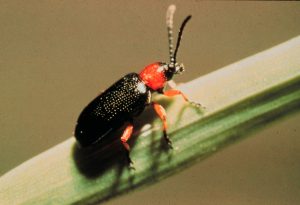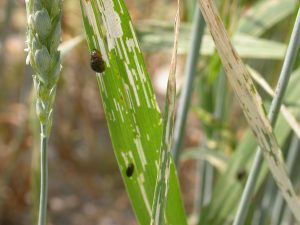Cereal leaf beetle, a pest of small grains, overwinters as an adult.

When temperatures warm, adults migrate to small grains to lay eggs; eggs are yellow-orange in color, usually in the midvein of the leaf, and may be single or several eggs end-to-end.

I saw a few eggs at our research center field today (March 9), they were a bit darker (and stickier) than their normal color. A female may lay 50 eggs. Larvae have orange-yellow bodies with dark heads and legs, but often appear as shiny black due to the covering of mucus and fecal matter they have on their body (they look like small slugs).

Larval feeding strips leaves of phytosynthetic tissue and can cause reductions in grain quality and yield. A temperature-based model developed using Virginia and North Carolina data shows that peak egg lay occurs at approximately 182 degree-days (using January 1 as a biofix; a lower development threshold of 8℃, and an upper development threshold of 25℃). With our warm February 2023 temperatures, we hit an earlier-than-normal peak egg threshold in Suffolk, VA on March 3 (I used the Tidewater AREC WeatherSTEM as my temperature source). The larval peak follows the egg peak by an average of 17.5 days, which would be the third week of March for Suffolk. It is important to note that the model states that extremely hot or cold years may affect its accuracy. Dominic Reisig (Professor and Extension Specialist, North Carolina State University) posted that the Salisbury, NC egg peak was predicted to occur on March 5-11, but a cooler forecast may push back the larval peak to the last week of March. As of March 8, Warsaw, VA is at 123 degree-days for cereal leaf beetle and the Eastern Shore has accumulated 119 degree-days.
To scout for cereal leaf beetle, inspect 10 tillers (stems) in at least 10 different sites. If you are seeing mostly eggs, you should scout again in 5-7 days when some have hatched into small larvae. The eggs may be parasitized. Both Virginia and North Carolina recommend an economic threshold of 25 eggs + small larvae (total) per 100 tillers. At least half of that 25 should be larvae. An insecticide spray, if needed, should target the newly-hatched larvae. Please refer to pages 4-44 and 4-45 of the Virginia Cooperative Extension 2023 Field Crops Pest Management Guide for additional information and spray recommendations. Another useful resource is a Journal of Integrated Pest Management article by Philips et al. (2011), Fifty Years of Cereal Leaf Beetle in the U.S.: An Update on Its Biology, Management, and Current Research.
